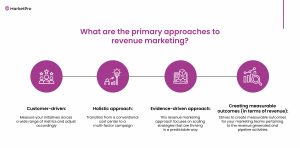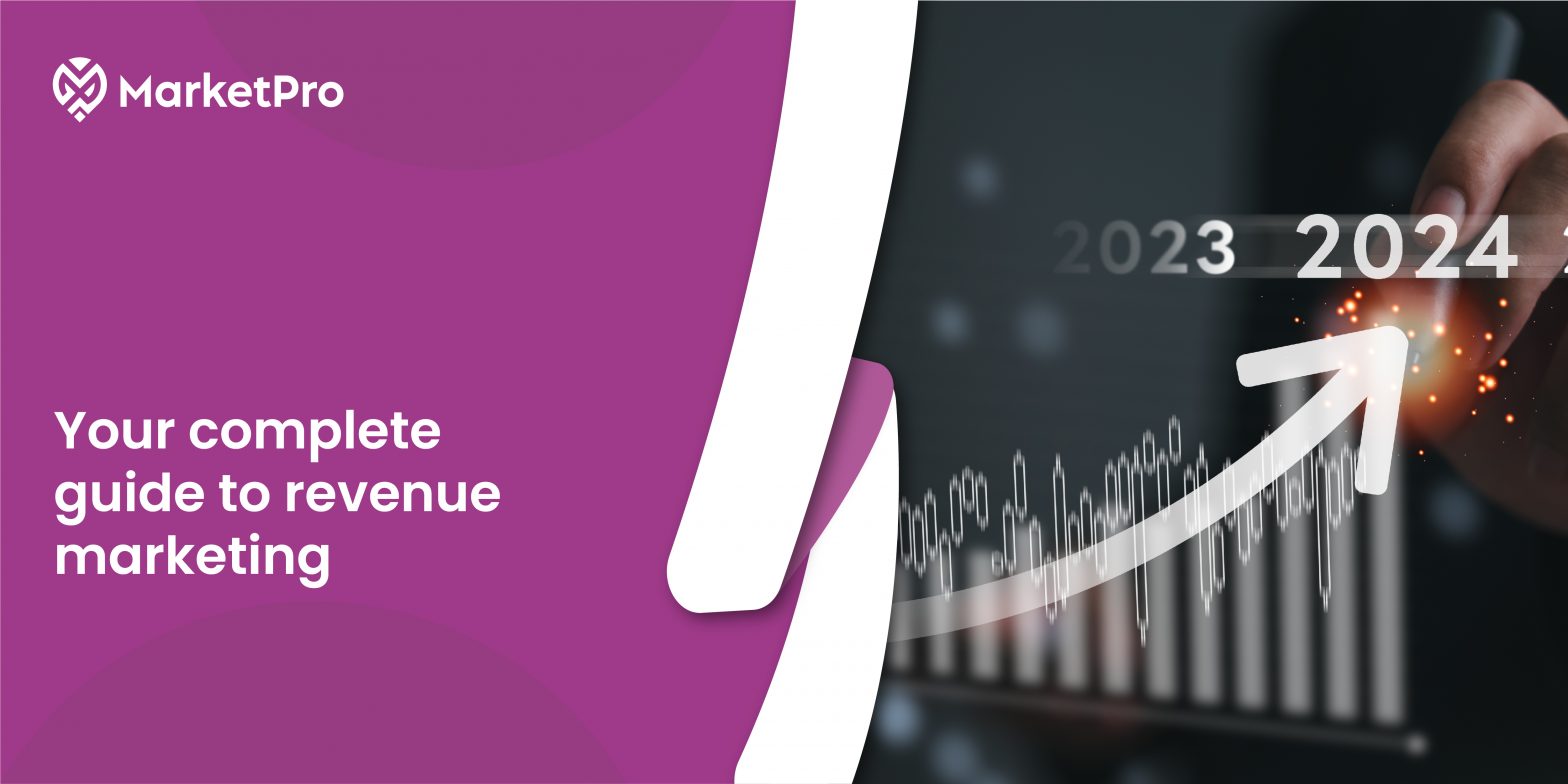Revenue marketing is a strategic approach that involves marketing strategies that align closely with sales goals and emphasize higher ROI. It also involves creating marketing strategies that prioritize converting potential prospects into customers and nurturing leads. Additionally, brands are able to drive repeat customers with a proven revenue marketing strategy.
During a short coffee session, Mark and Stacy discuss their marketing strategies. Mark explains how he prioritizes data-driven marketing and encourages effective collaboration between his sales and marketing departments. He emphasizes that behind every step he takes in his marketing campaign, he has one goal: Generating the most revenue.
On the other hand, Stacy explains how she only adopts traditional strategies that increase brand awareness for her product. She is worried because while she is getting a good engagement, none of her strategies are giving her the revenue she wants. Mark decides to help Stacy in creating an excellent revenue marketing strategy. Here are all the insights he had to offer.
What is Revenue Marketing?
Revenue Marketing is simply designing marketing strategies that help generate leads that convert to revenue.
Regardless of the strategy adopted, whether it is content generation, email marketing, SEO, ads, or simply PPC, it is designed with one primary goal: to convert traffic into substantial leads. However, it is more complex than it sounds; Revenue marketing seems less complicated if you have industry-related data and a deep understanding of consumer needs.
Revenue marketing also requires the sales and marketing team to work in conjunction. Marketers can boost customer acquisition and generate sales using different channels and methods. They do this by reducing silos, encouraging open communication, promoting effective collaboration between teams, and, most importantly, conducting a deeper analysis of consumer behavior.
Why is Revenue Marketing the best way to design a Marketing Strategy?
According to the B2B Lead Generation Benchmark Report 2023, Revenue marketing increases sales and generates more leads. Here are some top benefits of revenue marketing in 2024.
- It generates leads that can be converted into sales, generating good ROI.
- Ensures successful sales attribution to specific campaigns, offering companies a chance to replicate strategies.
- Offers greater collaboration and alignment between marketers and sales teams.
- By mapping out customer journeys, companies can create more personalized and targeted content for their users.
- Reliance on data analytics helps companies optimize their strategies.
How can you implement an excellent revenue marketing strategy?
Implementing an excellent Revenue Marketing strategy involves aligning your marketing efforts with revenue goals and employing data-driven tactics to maximize ROI.

1. Eliminate Silos: Promote Sales and Marketing Collaboration
At Stacy’s company, departments worked in isolation. John, who is in sales, has no idea what Baron is doing in the marketing department. This meant that strategies were not designed with the same end goal. The marketing department analyzed strategies based on the generated traffic, while the sales only had revenue in mind.
When sales and marketing teams collaborate, they can generate a higher ROI. Every marketing strategy is designed with higher sales in mind. Study. According to the latest statistics, a sales-marketing alignment helps generate 208% higher revenue for brands.
2. From Big Data to Smart Data: Focus on Data-Driven Marketing
Gone are the days when marketers made decisions on gut alone; times have changed, and data has become more relevant than ever. However, only some companies rely on data before making decisions. Even the ones that depend too much on big data (Data with little context or categorizations).
Stacy’s company relied on big data; her department focused entirely on using primary reports before adopting any strategy. For instance, they shifted from using mega-influencers to micro-influencers when the latter’s hype grew. But this was a big mistake.
They did this without realizing that their product was health-related and needed some big celebrity names to beat the competition, and micro-influencer campaigns would not cut it. This is where smart data comes in. By leveraging data analytics, your company can understand consumer behavior, preferences, and pain points and design strategies that work well.
“The end has come for making marketing decisions based on gut instincts; everything marketers do in the digital world can now be tracked, from the first click all the way to the deal close. CMOs who do not embrace and accept this concept will likely not be CMOs for very long.” Kurt Andersen, EVP Marketing and Sales Enablement, Savo
3. Focusing on Key Accounts: A well-designed Account-Based Marketing
B2C marketing primarily focuses on broad marketing strategies that appeal to many consumers. B2B marketing targets a specific niche. Account-based marketing goes a step forward.
As part of the revenue marketing strategy, your marketing and sales team focuses on finding high-value accounts to generate the best ROI. By adopting personalized marketing strategies, you can target each of these accounts separately.
For example, think of a software company eager to sell its services. It would be wise for them to target Fortune 500 companies with higher buying power and a tendency to invest in the product.
ABM can be tiring and exhausting. However, it does what only some strategies can do well- generate more revenue than many other strategies combined.
4. A Lead Scoring system: Focusing on Leads that are likely to convert
Another strategy that Mark’s marketing department focused on was implementing an excellent lead-scoring system. A lead scoring system assigns point values to different criteria based on their importance. For example, if your customers download a whitepaper, you’d assign it 10 points. On the other hand, if they attend a webinar, you’d assign them 20 points.
Companies must also set a threshold to determine when a lead is qualified and ready for sales engagement. For instance, if the leads score above 50 points, your company may consider it an appropriate amount to be passed onto the sales team.
Additionally, your company can rely on CRM integration and marketing automation tools to track its leads and get its total scores automatically. On top of that, through lead segmentation, leads can be categorized into different groups to help marketers strategize better.
5. Tracking and Measuring: Analyzing ROI is critical to a good strategy
Mark had a final card in his deck and decided to reveal it. He suggested that Stacy hire individuals who track and measure campaign ROI and make changes accordingly.
Regarding revenue marketing, the only criteria that should matter is what works and what does not. The Content Marketing Institute reports that 65% of the most successful B2B marketers have a documented ROI measurement strategy.
For example, Cisco uses detailed analytics to track the performance of its content and campaigns, allowing it to allocate resources effectively and optimize its revenue marketing strategy.
Suggested Read: Content Marketing Strategy: Top 10 Ingredients of Crafting Compelling Content.
Other proven strategies that Support Revenue Marketing
The above strategies work- but they work in collaboration. Here are some additional techniques brands can implement to drive up sales.
- Pay per Revenue Marketing: This is a performance-based advertising model where marketers’ compensation is aligned directly with the financial success of the campaign.
- Social Media Management Service: Social media marketing helps create engagement within the community, thus building a community around your brand.
Suggested Read: Top 8 Most Crucial Social Media Marketing Trends to Look Out for in 2024
- Professional PPC Management: Professional PPC (Pay-Per-Click) Management involves experts overseeing and optimizing PPC ad campaigns to maximize ROI by effectively targeting the right audience
- Search Engine Marketing: Search Engine Marketing (SEM) is a digital marketing strategy that promotes websites by increasing their visibility in search engine results pages through SEO optimization.
Wrapping up Revenue Marketing is a game changer for the new Age of Marketing.
Traditional marketing was safe, secure, and reliable; there is only one issue: it no longer works. As a Marketing strategist, you need to eliminate silos, encourage market-sales collaboration, invest in lead scoring, and adjust your campaign strategies to meet the changing trends- all to move toward revenue marketing.
If you are somebody like Stacy, you might think that shifting from traditional marketing strategies to one dependent on revenue marketing can be daunting. But that is not the case. Marketpro made this shift years ago and developed game-changing strategies for all its clients. By encouraging collaboration between different teams, Marketpro ensures that revenue is a primary goal for all your campaigns.
So don’t rely solely on brand awareness and engagement when revenue marketing can offer you so much more. Contact us today to learn more.

